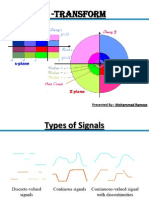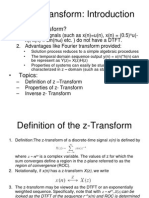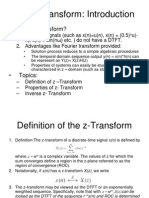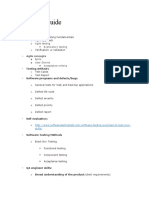Digital Signal Processing
Ciira wa Maina
ciira.maina@dkut.ac.ke
1 Summary
This lecture will focus on:
1. The z-transform
2 z-Transform
The z-transform of a discrete time sequence x[n] is defined as
∞
X
X(z) = x[n]z −n
n=−∞
Here, z is a complex variable and the z-transform is an infinite sum. Recall that the Fourier
transform of a discrete time sequence x[n] is defined as
∞
X
jω
X(e ) = x[n]e−jωn
n=−∞
We see that if z = ejω the z-transform reduces to the Fourier transform. This corresponds to
setting |z| = 1. That is the Fourier transform is the z-transform evaluated on the unit circle.
2.1 The Region of Convergence
The z-transform does not converge for all sequences or for all values of z. The values of z for
which the z-transform converges for a particular sequence is known as the region of convergence
(ROC). The ROC is a ring in the z-plane. If the ROC includes the unit circle, then the Fourier
transform converges. It is useful when a closed form expression for the z-transform can be found
and X(z) can be expressed as a rational function
P (z)
X(z) =
Q(z)
with P (z) and Q(z) both polynomials in z. The values of z for which X(z) = 0 are known as the
zeros of X(z) while the values of z for which X(z) is infinite are known as the poles of X(z).
1
�2.1.1 Examples
Compute the z transform of the following sequences clearly indicating the region of convergence
1. δ[n]
2. u[n]
3. −u[−n − 1]
4. x[n] = an u[n]
5. x[n] = −an u[−n − 1]
2.1.2 Properties of the Region of Convergence
1. The ROC is a ring in the z-plane centered at the origin: 0 ≤ rR < |z| < rL ≤ ∞
2. The Fourier transform of x[n] converges absolutely if and only if the ROC of the z-transform
of x[n] includes the unit circle
3. The ROC cannot contain any poles
4. If x[n] is a finite duration sequence then the ROC is the entire z-plane with the possible
exception of z = 0 or z = ∞
5. If x[n] is a right sided sequence then the ROC extends outward from the outermost finite
pole in X(z).
6. If x[n] is a left sided sequence then the ROC extends inward from the innermost nonzero
pole in X(z).
7. If x[n] is a two sided sequence then the ROC will consist of a ring in the z-plane bounded
on the interior and exterior by a pole.
2.2 The Inverse z-transform
2.2.1 By Inspection
If the z-transform is already known and tabulated, then we can determine the sequence by in-
spection.
2.2.2 Partial Fraction Expansion
Let X(z) be expressed as a ratio of polynomials in z −1
PM
k=0 bk z −k
X(z) = PN
−k
k=0 ak z
We can also write QM −1
a0 k=1 (1 − ck z )
X(z) = QN
b0 k=1 (1 − dk z −1 )
2
�where the ck ’s are the nonzero zeros of X(z) and the dk ’s are the nonzero poles of X(z). If M < N
and all the poles are of first order, then we can write
N
X Ak
X(z) =
1 − dk z −1
k=1
This is the partial fraction expansion of X(z) and the coefficients can be found as
Ak = (1 − dk z −1 )X(z)|z=dk
The corresponding sequence can now be found by table lookup.
Example: Consider the sequence whose z-transform is
1 1
X(z) = 1 −1 1 −1 , |z| >
(1 − 4 z )(1 − 2z )
2
















































































